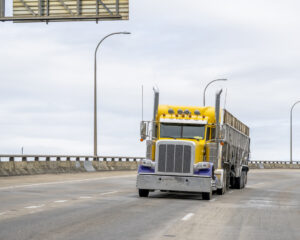ST. LOUIS — The water level of the Mississippi River is unusually low for the third straight year, forcing barge companies to put limits on how much cargo they can carry and cutting into farm profits.
It was just two months ago that much of the Mississippi River was above flood stage north of St. Louis. Since then, the river level has dropped steadily. The area south of St. Louis has been hit especially hard, mirroring low-water concerns that began around this same time of year in both 2022 and 2023.
As part of the fallout, barge companies are forced to limit the soybeans, grain and other cargo they carry to prevent barges from potentially getting stuck. That means less profit for farmers.
About 60% of U.S. grain exports are taken by barge down the Mississippi to New Orleans, where the corn, soybeans and wheat is stored and ultimately transferred for shipment to other countries. It’s an efficient way to transport crops — a typical group of 15 barges lashed together carries as much cargo as about 1,000 trucks.
With cargoes limited, the U.S. Department of Agriculture’s most recent Grain Transportation Report showed that for the week ending Aug. 31, 480,750 tons of grain moved on barges — a 17% drop from the previous week.
“When you’ve got a transportation cost increase in any industry the question is, ‘Do I pass those costs onto the customer in the form of a higher price?’” Steenhoek said.
But farmers usually don’t have that option because their product that moves on barges is being sold internationally. If American soybean prices rise, the foreign buyer can purchase from another country, Steenhoek said.
All that water flowing down from the upper Mississippi River was offset by drought in states along the Ohio River, which feeds into the Mississippi at Cairo, Illinois. Rainfall in places like Ohio and West Virginia was minimal throughout the summer, worsening in August.
“That drought is growing,” Michael Clay, chief of the Hydraulics and Hydrology Branch of the Corps of Engineers’ office in Memphis, Tennessee, said at a news conference Wednesday. As a result, the Mississippi River south of Cairo is just a few feet higher than the record low levels reached in several places last year — and dropping.
Donny Davidson Jr., a deputy engineer for the Memphis District of the Corps, said dredging operations are being moved around on a frequent basis as worrisome spots pop up.
“Over the last few years, we’ve really got very good at looking ahead and applying those resources in a very strategic manner,” Davidson said.
Clay said Hurricane Francine is expected to bring several inches of rain to much of the lower Mississippi River, including up to 4 inches of rain in Memphis in the coming days.
The Associated Press is an independent global news organization dedicated to factual reporting. Founded in 1846, AP today remains the most trusted source of fast, accurate, unbiased news in all formats and the essential provider of the technology and services vital to the news business. The Trucker Media Group is subscriber of The Associated Press has been granted the license to use this content on TheTrucker.com and The Trucker newspaper in accordance with its Content License Agreement with The Associated Press.








